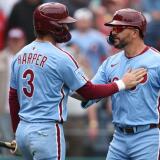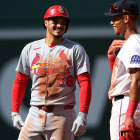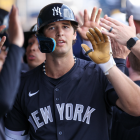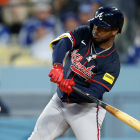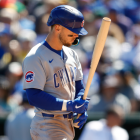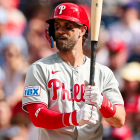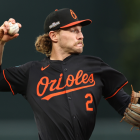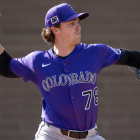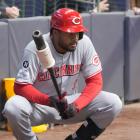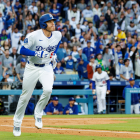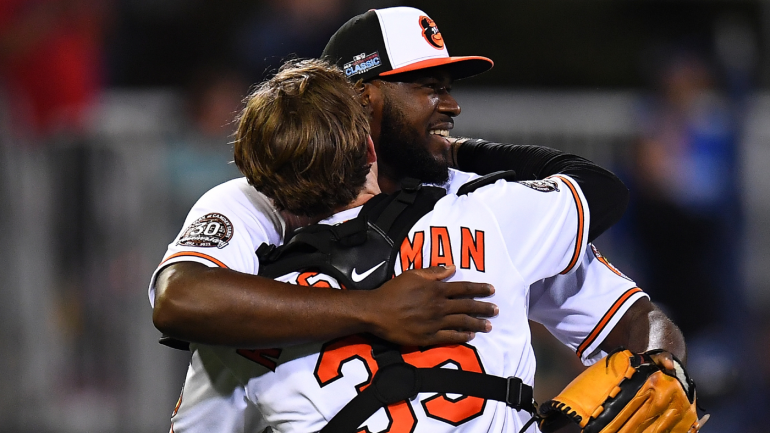
At 65-59, the Baltimore Orioles are enjoying their most successful season since the days of Chris Tillman atop the rotation and JJ Hardy at shortstop. The O's have already won more games this season than any season from 2017-21, and there's still a month to play. The roster has young talent and the farm system is excellent. Baltimore is finally on the rise.
Here, to drive home that point, are the AL East standings since the cherry-picked date of May 18:
- Baltimore Orioles: 51-35
- Toronto Blue Jays: 48-37 (2.5 GB)
- New York Yankees: 49-39 (3 GB)
- Tampa Bay Rays: 46-40 (5 GB)
- Boston Red Sox: 45-43 (7 GB)
Yes, the Orioles have the division's best record over the last three months or so. Only the Houston Astros have a better record in the American League during that time. They are 57-31, five games better than the O's. And Friday night, the Orioles and Astros, two kindred baseball spirits, open a three-game series at Minute Maid Park in Houston.
"This is what we were working for in Baltimore," Trey Mancini, who was traded from the Orioles to the Astros at the deadline, told the Washington Post earlier this month. "What you have here (in Houston) is the end result of all that."
A decade ago the Astros were the hardest of hard tankers, losing at least 106 games every year from 2011-13. Those seasons netted them three No. 1 overall picks, plus they made shrewd trades to further stock the farm system. The tide began to turn in 2014, and in 2015 the Astros returned to the postseason. In 2017, they won a title, and Houston is often held up as the gold standard for a rebuild. (Of course, the sign-stealing cloud hangs over that era of Astros baseball.)
Ignoring the pandemic-shortened 2020 season, the Orioles lost at least 108 games every year from 2018-21, which brought them several high draft picks. They also stripped their roster down to the studs to add depth to the farm system. In 2022, the tide is turning for the O's much like it did for the Astros in 2014. A postseason spot should be the expectation in 2023, especially with the 12-team format.
The early 2010s Astros and current Orioles have more in common than philosophies. O's GM Mike Elias was the Astros' scouting director and later assistant general manager during their tanking years. Baltimore hired Elias away from Houston in Nov. 2018 and he brought some Astros personnel with him, most notably assistant general manager and analytics guru Sig Mejdal.
"Sig Mejdal is one of the most experienced and accomplished analysts working in baseball today," Elias said in a statement after hiring Mejdal a few days after joining the O's himself. "To have him join our Orioles organization is a major moment for this franchise, and I look forward to him charting the course for all of our forthcoming efforts in the analytics space."
Generally speaking, Elias and Mejdal and their staff have used the same process that turned the Astros from bottom-feeders into World Champions to rebuild the Orioles. The game is always evolving and what worked 10 years ago doesn't necessarily work now, but Astros and Orioles blueprints are similar, and there is more than a little front office overlap.
Here's a look at what the Orioles have done to get to where they are today -- not a bona fide contender yet, but heading in that direction -- and what comes next.
1. Elias inherited some talent
Elias would be the first to tell you a rebuild begins with players already in the organization. When Elias joined the Astros with then-GM Jeff Luhnow, they inherited Jose Altuve, Dallas Keuchel, and George Springer. Those three cornerstone players were brought into the organization by the previous front-office regime. The new regime helped develop them into All-Stars and awards winners, but they were Astros long before Elias and Luhnow.
The O's previous regime, led by Dan Duquette, left Elias several parting gifts, including first baseman Ryan Mountcastle (2015 draft) and outfielders Austin Hays (2016 draft), Cedric Mullins (2015 draft), and Anthony Santander (2016 Rule 5 Draft). Those four rank 1-2-3-4 on the club in plate appearances this season. Elias also inherited Mancini (third in the 2017 AL Rookie of the Year voting), who is still sixth on the club in plate appearances this year.
Key relievers Keegan Akin (2016 draft) and Dillon Tate (Zack Britton trade in July 2018) were other Duquette era pickups Elias & Co. are benefitting from now. The current front office and player development staff deserve credit for developing them into the players they are today. Ultimately, these players are key contributors to the 2022 Orioles, and they were with the organization long before the people currently calling the shots.
2. Rutschman became very good, very fast
The O's selected Oregon State catcher Adley Rutschman with the No. 1 pick in the 2019 draft -- finishing with MLB's worst record in 2018, and thus securing the No. 1 pick in 2019, was another parting gift left to Elias by Duquette -- and he finally made his MLB debut this May, after the pandemic threw a wrench into everyone's development and a triceps injury slowed him in spring training. Rutschman's arrival coincides almost perfectly with Baltimore's rise up the standings.
The case can be made Rutschman is already the best catcher in baseball. He went into Thursday's game hitting .257/.367/.452 overall, including .289/.406/.529 with 29 extra-base hits and more walks (37) than strikeouts (36) in his last 55 games. There is more to life that Statcast, but this is positively elite for any player, let alone a rookie catcher:
Willing to hear arguments Adley is already the best catcher in baseball. pic.twitter.com/YZjlkQ4OSN
— Mike Axisa (@mikeaxisa) August 25, 2022
Rutschman is fourth among catchers in FanGraphs WAR, which includes pitch-framing, despite not debuting until May 21. Earlier this week he quietly passed Mariners wunderkind Julio Rodríguez for the lead in FanGraphs WAR among rookies, though the difference (3.6 to 3.5) is well within WAR's error bars. That said, Rutschman is making AL Rookie of the Year race an actual race.
Rookie catchers who are as good and as well-rounded as Rutschman tend to go on to be superstars. We're talking a Buster Posey type here, except as a switch-hitter (!). The Orioles have their franchise cornerstone and it just so happens he plays the most demanding position on the field. Rutschman was been central to Baltimore's rise this year and will be a driving force for the next half-decade, if not longer.
"His game-calling is excellent," manager Brandon Hyde told MASN Sports about Rutschman earlier this month. "He's one of the best blockers in the league already, he's one of the best framers in the league already. The way he controls the pitching staff, his tempo, the energy behind the plate, the positive reinforcement. The pitchers know that he's trying to get them through their innings. The whole package. He does a great job."
3. A brand new bullpen
Teams have more information about pitchers than ever -- pitches are almost literally designed in a lab and taught to players these days -- yet relievers are still difficult to predict from one year to the next, even the very best (look at Josh Hader). The last thing a rebuilding team needs is a good bullpen, and the Orioles had a very bad bullpen the last few years. Now that they're transitioning from rebuilding to contending, a good bullpen was a must, and Baltimore has that now.
Look at the improvement in the O's bullpen performance from just last season:
| 2021 | 2022 | |
|---|---|---|
ERA | 5.70 (30th in MLB) | 3.19 (4th in MLB) |
ERA+ | 71 (30th) | 116 (5th) |
WHIP | 1.46 (29th) | 1.21 (8th) |
Strikeout rate (K%) | 21.5% (28th) | 22.7% (21st) |
Walk rate (BB%) | 10.0% (16th) | 7.9% (4th) |
Home run rate (HR/9) | 1.47 (30th) | 0.90 (8th) |
Win probability added | -6.94 (28th) | 5.51 (2nd) |
WAR | 2.5 (20th) | 3.8 (9th) |
Do the Orioles have a truly elite bullpen? No, not yet, but it is greatly improved. Baltimore had one of the worst bullpens in baseball last season, if not the worst, and nothing will sink a season faster than a bad bullpen. Granted, the O's weren't trying to compete, but even on occasions when they were in position to win, the bullpen made it tenuous.
The bullpen has since been overhauled. Six of the O's top eight pitchers in relief innings last season are no longer in the organization. The only exceptions are Tate, who has been the team's steadiest reliever for several years now, and Tyler Wells, who parlayed a solid rookie season in the bullpen into an opportunity as a starter this season. The others were all replaced.
Seven pitchers have thrown at least 40 relief innings for the Orioles this season. Look at the path they took to Baltimore's bullpen (listed in order of innings pitched):
- LHP Keegan Akin: 2016 draft pick struggled as a starter in 2021, moved into the bullpen full-time in 2022.
- RHP Dillon Tate: Acquired at the 2018 trade deadline and has been a mainstay since.
- RHP Félix Bautista: Signed as a minor-league free agent in Aug. 2016.
- RHP Bryan Baker: Claimed off waivers from Blue Jays in Nov. 2021.
- RHP Jorge López: Aug. 2020 waiver claim struggled as starter, moved into the bullpen full-time last August.
- RHP Joey Krehbiel: Claimed off waivers from Diamondbacks in Sept. 2021.
- LHP Cionel Pérez: Claimed off waivers from Reds in Nov. 2021.
López was an All-Star this season and traded away at the deadline, which was a clear indication the front office is not focused on maximizing the team's 2022 postseason odds even though they're in the wild-card race. Mancini is at least scheduled to hit free agency after the season. I can understand trading him. López is under team control through 2024, however. He could have helped the O's contend this year and the next two years, but nope. Traded away.
The López trade cleared the way for Bautista, a revelation this season thanks to his triple-digit fastball and swing-and-miss splitter (and slider), to take over the closer's role. He is another holdover from the Duquette era, though it wasn't until he won a job in spring training this year that he made his MLB debut. Now Bautista is a late-inning dominator with the coolest closer entrance in the game (sorry, Edwin Díaz).
Yo they played the Omar whistle from the Wire accompanied by a major light show when the Orioles Closer Félix Bautista entered the game tonight 🔥🔥🔥🔥🔥🔥🔥 https://t.co/F5YWiDV9Jv
— Matthew A. Cherry (@MatthewACherry) August 10, 2022
Cool closer entrance aside, look how the O's built their bullpen. You've got a minor-league free agent (Bautista), three pre-lockout waiver claims (Baker, Krehbiel, Pérez), and a failed starter (Akin). There is something to be said for investing big in a top reliever (Liam Hendriks has been worth every penny for the White Sox and I can't image the Mets regret the Díaz trade at this point), but taking small bites can work too. That's the approach Elias & Co. have taken.
And, of course, the bullpen is a perpetually ongoing project. Bautista has been awesome this season, but who's to say he will be a championship-level closer when the O's are ready to contend for a World Series? Baker, Krehbiel, and Pérez were on waivers for a reason and could show us that reason at any time. It was only two years ago that Nick Anderson and Matt Barnes were elite relievers, remember. Bullpen outlooks can change rapidly and the 2022 Orioles have a good bullpen. They'll have to continue working to make sure it remains good -- and gets better -- in the coming years.
"A lot of these guys, people haven't heard of coming into this year," Hyde told Baltimore Baseball in May. "... I really like the makeup of the guys down there, and I really like the stuff coming out of the bullpen, and that stuff plays regardless if you know them or not. They're learning the league, also. They've done a great job of pitching without fear, with confidence, and I look forward to them doing that the rest of the season."
4. 'Walltimore'
Camden Yards is one of baseball's best ballparks and the Orioles gave the 30-year-old stadium a rather significant facelift over the winter. They pushed the left field wall as far back as 30 feet in some locations, and also raised the wall height from seven feet to 12 feet. The goal was to cut down on home runs and create a more neutral playing surface.
"For any team, for any park to be toward the very, very extreme in either direction, it's a bit of a challenge," Elias told reporters, including the Baltimore Sun, after renovation plans were revealed in January. "It's something that has posed a challenge for this franchise, and we think that this will improve the playing conditions and the style of play in this part of the park and be beneficial towards us and the type of competition that occurs here going forward. A ball leaves the bat and it's a home run and no one expected it to be, nor is it a home run in 28, 29 other major-league parks, and the players feel that."
The new left field wall has had the intended effect. Camden Yards is averaging 1.87 home runs per game this season. It was 3.36 homers per game from 2019-21, so the home run rate has been cut almost in half. To left field only, 8.8 percent of fly balls and line drives have left the yard this season. From 2019-21, it was 13.5 percent.
Check out these two fly balls. They had nearly identical exit velocities, launch angles, launch directions, and distances traveled. Last season it was a homer, this season it didn't even make it to the warning track:
The Orioles were out-homered 642-485 from 2019-21, or nearly one homer every two games. It stood to reason the Orioles would benefit from the new left field wall -- "Walltimore," as some call it -- because giving up home runs has been a big problem the last few years. And that's exactly what's happened. Going into Thursday's game, the O's were being out-homered only 135-127 this year, so very close to an even differential. There is a lot more to Walltimore than fewer home runs, however.
For starters, left fielders must now play a bit deeper, resulting in more singles to shallow left. Line drives and fly balls to left have seen close to a 30-point increase in batting average at Camden Yards this year, and there are more doubles and triples too. Not every would-be homer with the old left field is an out now. Some bang off the wall for doubles or drop in for extra bases because the defender can't get there in time. Righty hitters like Jorge Mateo and Ramón Urías have benefitted from the added space in left field.
I also suspect Walltimore has helped the O's pitching staff beyond fewer homers allowed. I imagine Orioles pitchers now have greater confidence attacking the zone because they no longer have to worry about every little mistake landing in the seats. It can't be easy pitching in a home ballpark that is so extremely hitter friendly. In 2019, the last pre-pandemic season, O's pitchers threw only 47.2 percent of their pitches in the zone at Camden Yards. It's 50.4 percent in 2022, exactly the MLB average.
Obviously the pitcher himself has a lot to do with that, and we did just detail all the turnover in the team's bullpen. But surely the big new left field encourages pitchers to pound the zone a little more, right? Throw more strikes and it impacts everything. It leads to more pitcher-friendly counts, it puts hitters on the defensive, it creates more opportunities for swings and misses, so on and so forth. I don't think we can isolate what we'll call "pitcher confidence" statistically, but it definitely exists, and I could see how Walltimore would help O's pitchers that way.
Bottom line, the Orioles have greatly improved their pitching this season, both starters and relievers, and there's no chance that big (and far away) new wall in left field has nothing to do it with. Home runs are down. That is an undeniable fact. Whether there's also an impact on pitcher confidence that leads to on-field improvement is up for debate, but it's not the craziest idea in the world.
What comes next?
Now comes the hard part. Building a highly regarded farm system is a piece of cake. Turning that highly regarded farm system into a productive major-league roster and a World Series contender is the real challenge. The Tigers are learning that the hard way this season. The Phillies are in a similar situation. With the exception of Aaron Nola, their cornerstone players were all signed as free agents. They didn't come up through the system.
So what do the Orioles do next? Two things. First, continue promoting prospects. I mean, duh. Shortstop Gunnar Henderson, the consensus No. 1 prospect in the minors, could be promoted at any moment. There are no longer any service-time reasons to keep him in Triple-A (unless the O's are planning to manipulate his service time next year) and earlier this month Elias said Henderson is on the radar for a promotion.
"We're going to -- within reason -- do everything we can to enhance our playoff odds," Elias said during a recent radio interview. "I think this year is definitely on the table (for a Henderson call up). Right now we have a bunch of infielders that are playing pretty well ... As things evolve here the next month and a half, I think Gunnar is on the radar screen."
The O's summoned outfielder Kyle Stowers and (briefly) lefty DL Hall, two other touted prospects, earlier this month. Triple-A infielder and 2020 first rounder Jordan Westburg has done just about everything he needs to do to get a big-league opportunity. Clearly though, Henderson is the big name. He's torn the cover off the ball in the minors and, even if he can't put the Orioles over the top and into the postseason this year, letting him get his feet wet this year could pay dividends next year.
And second, spend. Spend spend spend. Baltimore entered the season with a $43.7 million Opening Day payroll, lowest in MLB. They were 27th in payroll in 2021, 29th in 2020, and 27th in 2019. As recently as 2017, the Orioles ran a $164.3 million payroll that was top 10 in MLB. The O's have the ability to spend significantly more than they have in recent years, and with the club showing signs of improvement (significant improvement) this season, it's time to up the payroll accordingly.
"Our plan for this offseason has always been to significantly escalate the payroll," Elias said earlier this month. "I think a lot of that's going to come through our own guys going into arbitration, but also we plan to explore free agency much more aggressively. We plan to maybe make some buy trades for some guys that are either on contracts or kind of in the tail-end of their arbitration ... I'm really looking forward to the offseason and kind of a winter meetings environment where we're buying. I think it's going to be a lot of fun for our group and for the organization."
What do the Orioles need to add this offseason? Another starting pitcher never hurts. Grayson Rodriguez, arguably the top pitching prospect in the minors, had his season derailed by a lat injury. A healthy Rodriguez surely would have made his debut at some point this summer and possibly fronted the rotation next year. Even then, bringing in another starting pitcher is never a bad idea. Noah Syndergaard stands out as a veteran starter with upside as he gets further away from Tommy John surgery.
I see no reason why the Orioles shouldn't be in on Carlos Correa. Correa is expected to opt out of his contract with the Twins and Elias drafted Correa back when he was Houston's scouting director. Henderson is a shortstop now, though there's some thought he may have to move to third base long-term. Even still, there are ways to make Correa and Henderson co-exist on the same roster. Mateo's having a nice year at short but shouldn't stand in the way of a player like Correa.
A few years ago the Cubs spent big on Jon Lester when they were ready to transition from rebuilder to contender. The Padres did this with Manny Machado (after doing it with Eric Hosmer first). The Rangers just did this with Corey Seager and Marcus Semien. I suppose Texas is a cautionary tale seeing how they're not contending this year, but Seager's held up his end of the bargain and Semien has been very good since a poor start. They're not dragging the Rangers down.
Point is, the Orioles are at a point now where sitting near the bottom of the league in payroll is unacceptable. Raising payroll only to accommodate arbitration raises is unacceptable. The farm system is pumping cheap young talent into the MLB roster and will continue doing so next year, and there are zero long-term commitments on the books. John Means is signed for $2.975 million next year and Jordan Lyles has an $11 million club option ($1 million buyout) and that's it. No other Orioles players are under contract beyond 2022. Elias has a clean payroll slate and should begin to use it this winter. The players are holding up their end of the bargain. They're performing. Time to reward that performance with a higher payroll and more help.
![[object Object] Logo](https://sportshub.cbsistatic.com/i/2020/04/22/e9ceb731-8b3f-4c60-98fe-090ab66a2997/screen-shot-2020-04-22-at-11-04-56-am.png)








